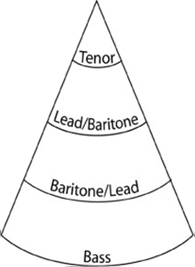This is Barbershop
You love music? Then you’ve come to the right organization. Sweet Adelines International takes singing to the next level—not simply a single melody but rather four-part, a cappella harmony—music created from four different voice parts that beautifully blend into one chord. Stunning and challenging, all in one!
Barbershop singing is one of the trickiest yet most rewarding accomplishments of a vocal ensemble. Imagine this: you’re singing a song with three other harmonizing ladies, each hitting the perfect pitch when bam—you hear it. An overtone vibration, a resonant ring, a different sound than any one tone being sung by any one singer! This overtone produces a visceral experience and is unique only to four-part barbershop harmonies!
Although the voice parts in women's barbershop harmony have different names and functions than they do in other SATB or SSAA vocal styles, the foundation is the same—beautiful music, stunning chords and a passion to create the intangible, moving essence of music that brings us together.
Here are the basics:
- You need to be able to sing in tune.
- You need to be able to hear those around you and blend your voice with theirs, as our organization emphasizes ensemble singing, not a solo-building group.
- You need to be able to eventually hold your own—that is, you will need to be able to sing your own part when surrounded by those who don’t. In a barbershop ensemble, there are many times when you are singing while standing by someone who isn’t singing your part.
- You will probably want to begin a normal warm-up routine at home before you practice. This will be good for your voice, and depending on what you choose to do for warm-ups, you can specifically work on many different skills at once (e.g., flexibility, range, breath control, dynamic [volume] control, etc.).
- In order to keep your level consistent and/or improve, you will want to make sure you have a plan for practicing the songs at home, either with the help of learning tracks or not. It’s just like exercising the body—if you do it on a regular basis, you will reap the benefits, and if you don’t, you’ll definitely see the decline.
Voice Parts in Barbershop Singing
In simple terms, barbershop harmony is vocal harmony produced by four parts: lead, tenor, baritone and bass. Finding the right part for your voice is the initial step. Any woman of average singing ability, with or without vocal training, will find a part that fits her range.
There are certain things you may want to know depending on the part you will be singing. Most of us are familiar with the SATB or SSAA choral music, where the melody is usually in the First Soprano line, above all others. The voice parts in barbershop harmony for women have different names and functions than they do in other SATB or SSAA vocal styles. The LEAD voice generally sings the melody and is below the TENOR harmony; the TENOR part sings the highest note in the chord; the BARITONE part fills in the all-important missing note in a chord that may be above and below the melody; the BASS part supplies the harmonic foundation (root or fifth) of the chord. Similar to choral music, minimal vibrato should be apparent in barbershop singing. Wide and obvious vibratos tend to hamper the “lock and ring” that we look for in our chords.
 THE BARBERSHOP CONE
THE BARBERSHOP CONE
Barbershop harmonies have a different balance than the traditional cylindrical balance of SATB or SSAA ensemble music. Our top voices sing with less weight and intensity than our lower voices.
Tenor is the highest singing harmony part, consistently sung above the melody (the lead) and she sings with a light, soft and clear tone, in a range usually between g above middle c and up to high f. A tenor compliments the lead without overshadowing the lead (not to be compared to a classical soprano).
Lead is the melody part, sung with clarity, warmth and authority and not too much vibrato. The range is usually like that of a 2:nd Soprano (from g or a below middle c, to high c). The lead is mainly responsible for the emotional communication and interpretation of the song.
Baritone has about the same range as a lead, but is sometimes above, sometimes below the melody line, filling out the chord with the fourth note. She provides the “glue” for locking the chords. Since the baritone line is winding around the lead line, they need to constantly adjust their balance depending on what position they have in the chord.
Bass is the lowest harmony part, sung with a rich, warm and resonant voice, often from E flat below middle c and up to g above middle c (lika a 2:nd alto or contralto). The bass part provides the foundation of the chord and needs to be sung with more volume and authority.
In a barbershop arrangement the baritone and bass lines are written in the bass clef, but they are sung an octave higher than written. This is due to the tight voicings and to make it visually easier to read.
Education and member section
Nordic Light Region provides superb, unmatched educational opportunities. Go to education area in the top menu
Our membership department will tell you all you need , read more about membership forms and don't hesitate to contact us [email protected]
Join us and see what Nordic Light Region have to bring in to your life!



